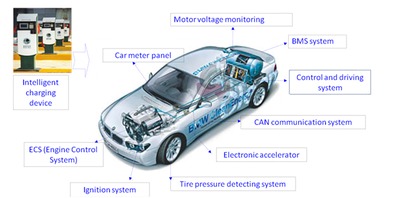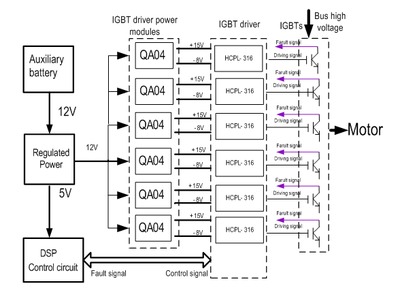Power module solutions for the automotive electronics industry
Friday, 27 September, 2013
Automotive electronic technologies are popularly applied for use in many and varied applications in electric, hybrid-electric and conventional vehicles. Isolated DC-DC converters are mainly used in automotive electronic systems for stable sampling and control signal isolation. This article indicates where DC-DC converters are commonly used in automotive applications.


Power modules for the BMS system
Description of BMS and power requirement
The BMS system is at the heart of battery-powered electric vehicles. BMS offers online detection and real-time monitoring providing battery voltage, current temperature SOC and insulation status information, etc. Also, it can in real time identify the running state of the batteries and battery pack’s discrete characteristics.
Different batteries have their individual internal characteristics; these characteristic differences would affect the charge-discharge ability of the battery (what is called the discrete nature of the battery pack). BMS systems monitor this discrete situation in the battery/pack and modify the charge accordingly. When it fails, the CPU sends a fault signal and gives an alarm to the controller.

Isolation should be used when sampling current, voltage, SOC, temperature etc signal, and the isolation voltage of the DC-DC converter is dependent on the number of battery cells. One should use a power module that incorporates material approved for AEC-Q100 applications. Finally, the operating temperature of the DC-DC converter needs be -40 to 125°C.
Solution
For this power requirement, Mornsun has created an automotive-grade DC-DC converter. The CF0505XT-1W has the following parameters:
- Operation temperature of -40 to 125°C
- Up to 3500 VDC isolation voltage
- Satisfies AEC-Q100 requirements
- Short-circuit protection
- Low ripple and noise
The product’s datasheet can be downloaded from www.mornsun-power.com//UploadFiles/pdf/TD_DCAN_EN.pdf.
Power modules for motor controller
Description of the motor controller
The motor controller is in charge of driving and protecting the motor.

One needs a positive/negative output voltage for turning on/off the IGBT, and the negative output voltage should be less than the positive output voltage to reduce energy consumption. In this application, the IGBT will have a very high dv/dt, which creates a high level of interference to the DC-DC converter; so the DC-DC converter needs to have a high isolation voltage and, as the motor controller is close to the motor, it should have a high operation voltage.
Solution
For this power requirement, Mornsun’s DC-DC converter QA04 is specifically designed for automotive IGBT drivers. Its parameters include:
- Operation temperature of -40 to 105°C
- Up to 3000 VAC isolation voltage; isolation cap low to 10 pF
- Positive/negative output voltage of 15 V/-8.7 V; 26% energy saved
- Up to 1000 uF max capacitive load
- Start-up without overshooting
- Short-circuit protection
The product’s datasheet can be downloaded from www.mornsun-power.com/UploadFiles/pdf/QA04_EN.pdf.
Intelligent charger power supply
Overview of application
Intelligent chargers control the charging current according to the battery pack’s charging curve. During the charging process, it can equalise the charge of the battery pack, ensuring that all the cells reach the upper charge voltage limit simultaneously and minimise nonconformities caused by differences of cell material, production and operation in the battery pack, which greatly enhances the available capacity and service life of the battery pack. Intelligent chargers are now being widely used for quick charging of electric city buses and hybrid buses.

As shown above, quick charging of the battery is achieved by the main charger in the early stages of charging. In general, the charge current is 30 A; however, due to the diversity of the batteries, some batteries will be fully charged sooner while some will be charged later. If the high charge current is maintained at the terminal stage of charging, the already fully charged batteries may be damaged by overcharging. Therefore, a control board is provided to monitor the battery cell voltage in real time through the battery monitoring unit to determine the state of the battery.
When the battery is to be fully charged, the main charging power supply switches off and the constant-current charge will be made by the auxiliary charge power supply by Mornsun’s URB2404LD-3000.
As the accuracy of the batteries’ voltage acquisition may be influenced while the auxiliary charge power supply is charging, the auxiliary power supply will, every second, be switched off twice by the remote switching-off function of Ctrl pin on the auxiliary power supply during the charge cycle. The battery voltage will be accurately monitored during the switching-off interval and cycle until the batteries are fully charged. Then the auxiliary charge power supply can be shut down; in this way all the batteries can achieve a full charge.
Solution
For this power requirement, Mornsun’s URB2404LD-3000 automotive equalising auxiliary charge power supply suits the application. It features:
- Constant output of 3 A
- Remote control and output voltage trimming
- Wide input of 9-36 V
- Isolation of 1500 VDC
- Short-circuit protection
- Two choices of charging voltage of lithium battery: 3.3 and 3.7 V
The product’s datasheet can be downloaded from www.mornsun-power.com/UploadFiles/pdf/URB2404LD-3000_EN.pdf.
A fluid battery that can take any shape
Using electrodes in a fluid form, researchers have developed a battery that can take any shape.
Key factors to consider with fire protection for an EV battery
This article explores some factors for EV battery designers to consider when deciding on...
Researchers claim record PV efficiency for kesterite solar cell
UNSW researchers have reportedly set a new record for a kesterite solar cell, which could be a...





